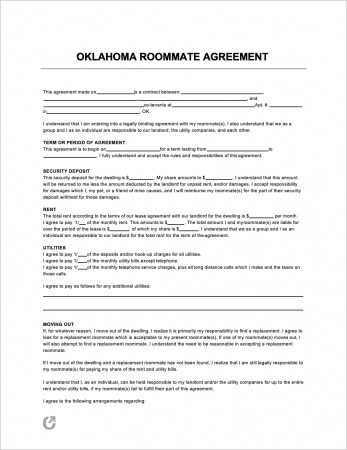
Oklahoma rental lease agreements are contracts for renting out vacant dwellings for a set amount of time. Their duration usually extends twelve (12) months; however, the tenant and landlord can negotiate shorter or longer periods. Both parties must abide by the requirements listed in the signed document. The tenant is legally responsible for making consistent rental payments and following all mandated rules. Landlords can evict any person who violates these regulations.
Before signing the lease, landlords must screen tenants via a rental application to assure their credibility and reliability. In this process, they perform a background check, which ensures the individual has a good credit history and would make the payments as expected. It also confirms that the individual has no criminal record that might otherwise indicate they would damage the property or commit other unfavorable actions.

Commercial Lease Agreement – A full-service form for negotiating every possible topic pertaining to renting out property that will be used for business purposes.

Lease to Own Agreement – A combination of a standard lease and a purchase agreement. Used for leasing out homes to tenants, while simultaneously giving them the option of purchasing the rental at the end of the rental period.

Month-to-Month Lease Agreement – Commonly used for vacation homes and other properties that would be impractical to lease on a yearly basis. Can be terminated by either party so long the appropriate notice is given (typically thirty (30) days).

Roommate Agreement – A document for establishing rental-wide rules that all roommates are obligated to follow (once they all sign the form).

Standard Residential Lease Agreement – For renting homes, apartments, condos, rooms, and other livable property to tenants. Has a “standard” lease term of one (1) year.

Sublease Agreement – So long the landlord permits subleasing, the form allows a tenant to introduce another tenant to take over lease payments and live in the property in the original tenant’s absence.
An Oklahoma Lease Agreement is a legal document used in property management for setting rules regarding the leasing of a residential or commercial property. A lease is signed after a landlord successfully approves of one (1) or more tenant(s) via a rental application.
Laws: Title 41
Landlord-Tenant Guides / Handbooks
Per § 41-109, rent should be paid on the date the parties agreed to in the lease agreement. Unless otherwise stated by the contract, one (1) month’s rent must be paid at the beginning of each month for longer terms. For terms of one (1) month or less, the rent will be payable at the beginning of the term. There is no grace period offered by state law.
Emergency (§ 41-128(B)): In emergencies, the landlord has the right to enter the rental dwelling without giving prior notice to the tenant.
Non-Emergency (§§ 41-128(A), 41-128(C)): If the landlord wants to access the rental dwelling for a reason not classified as an emergency, they must provide the tenant with at least one (1) day’s notice of their intent to enter. Additionally, they can only enter the rental at “reasonable” times. Common reasons for entry include making necessary or agreed-upon repairs, decorations, alterations, or improvements, or inspecting the premises.
Oklahoma law § 41-118 states the duties of landlords as follows:
Per § 41-127, tenants must uphold the following duties and obligations for the full term of the lease:
Maximum: State law does not dictate how much a landlord can charge a tenant for a security deposit.
Returning to Tenant (§ 41-115(B)): The tenant must make a written demand for the return of the security deposit within six (6) months after the termination of the tenancy. If they do not, the deposit will revert to the landlord. The money covers the amount needed to maintain the escrow account that keeps the security deposit.
If the landlord plans to keep any portion of the security deposit, they must itemize any damages in a written statement. They must deliver the statement by mail and return the balance of the security deposit without interest to the tenant within thirty (30) days after the termination of tenancy, delivery of possession, and the written demand by the tenant.
Deposit Interest (§ 41-115(B)): Landlords do not have to collect and pay tenants any accrued interest on security deposits.
Uses of the Deposit (§ 41-115(B)): Deductions can be made to remedy the following: